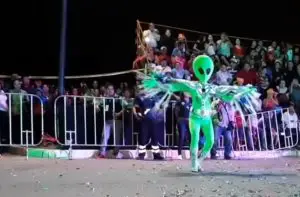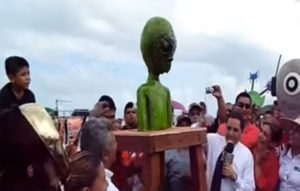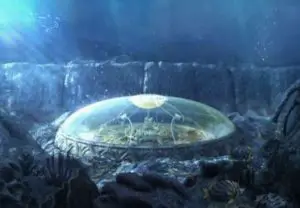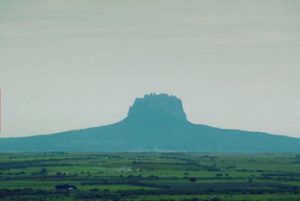Podcast: Play in new window | Download
Subscribe: Apple Podcasts | RSS
 In October of 2013, Ernesto Chavana, a local host on the Multimedios Televisión Network from the Mexican state of Nuevo León, encouraged his viewers to do something very unusual. The previous month, Hurricane Ingrid rocked the Gulf Coast of Mexico. The destructive storm, whose winds peaked at 85 miles per hour, veered away from its intended target, the highly populated tri-city area at the extreme southern tip of the Mexican coastal state of Tamaulipas. Instead of hitting the cities of Altamira, Ciudad Madero and Tampico with full force, Ingrid made a surprise turn to the northeast. After this turn, it weakened a bit and then made landfall near a town called La Pesca in a sparsely populated part of the state. The storm’s damage was not as severe as it could have been. The last time a hurricane slammed into the southern coast of Tamaulipas with devastating results was on September 19, 1955. Hilda, a category three hurricane, flooded 90% of Tampico leaving tens of thousands of people homeless and destroying the oil refineries in the area. Other storms seemed to tease the region for about a decade after that, occasionally making landfall and causing minimal damage. The television host mentioned on air that the three Gulf cities had been spared disastrous weather since 1966, with every major tropical storm and hurricane skirting around Altamira, Ciudad Madero and Tampico. Señor Chavana implored his audience to give thanks where thanks was due and summoned his viewers to hold a fiesta in the three lucky coastal cities to honor the real protectors of the cities: the extraterrestrials that have been watching over the area for decades. Chavana was not alone in believing this. Even some newspaper stories throughout the years either asked the aliens for help or credited them for so many close calls. So, on October 29, 2013 El Día del Marciano – or in English, “The Day of the Martian” – was born, a uniquely Mexican way to celebrate supposed otherworldly assistance from non-earthly beings.
In October of 2013, Ernesto Chavana, a local host on the Multimedios Televisión Network from the Mexican state of Nuevo León, encouraged his viewers to do something very unusual. The previous month, Hurricane Ingrid rocked the Gulf Coast of Mexico. The destructive storm, whose winds peaked at 85 miles per hour, veered away from its intended target, the highly populated tri-city area at the extreme southern tip of the Mexican coastal state of Tamaulipas. Instead of hitting the cities of Altamira, Ciudad Madero and Tampico with full force, Ingrid made a surprise turn to the northeast. After this turn, it weakened a bit and then made landfall near a town called La Pesca in a sparsely populated part of the state. The storm’s damage was not as severe as it could have been. The last time a hurricane slammed into the southern coast of Tamaulipas with devastating results was on September 19, 1955. Hilda, a category three hurricane, flooded 90% of Tampico leaving tens of thousands of people homeless and destroying the oil refineries in the area. Other storms seemed to tease the region for about a decade after that, occasionally making landfall and causing minimal damage. The television host mentioned on air that the three Gulf cities had been spared disastrous weather since 1966, with every major tropical storm and hurricane skirting around Altamira, Ciudad Madero and Tampico. Señor Chavana implored his audience to give thanks where thanks was due and summoned his viewers to hold a fiesta in the three lucky coastal cities to honor the real protectors of the cities: the extraterrestrials that have been watching over the area for decades. Chavana was not alone in believing this. Even some newspaper stories throughout the years either asked the aliens for help or credited them for so many close calls. So, on October 29, 2013 El Día del Marciano – or in English, “The Day of the Martian” – was born, a uniquely Mexican way to celebrate supposed otherworldly assistance from non-earthly beings.
 The Day of the Martian may seem strange to outsiders. To ancient and modern Mexicans alike, having festivals to thank the gods, the saints or other unseen forces is part of the everyday cycle of life dating back thousands of years. Every modern Mexican town or city has a patron saint, and each saint has a feast day, or fiesta, as per the Catholic calendar. For some Mexican towns the día del santo, or saint’s day, is the most important civic celebration of the year, even more important than some of the major holidays such as Christmas, Easter or Mexican Independence Day. Depending on the town, a fiesta may last for several days or a week. Religious fiestas usually have some common elements to them. In addition to much food, drink, and music, there is usually a solemn procession, during which a saint statue or other religious relic is paraded through town or throughout the countryside. Fiestas may also include associated sporting events, such as rodeos, and a general carnival atmosphere. Citizens of smaller towns may save up extra money all year to help put on a lavish saint’s day. Sociologists who study the fiesta phenomenon believe that the intense celebration for a brief time serves not only as a release of tensions and frustrations but provides a way for people to find more solidarity as a community. One of the primary reasons for honoring a specific saint who may be the patron of a town or region is to give thanks. The fiesta is also a time for individual participants to take personal inventories of the bounties from the previous year. It was in the spirit of the traditional Mexican fiesta that Ernesto Chavana inaugurated the first Day of the Martian which is now celebrated on the last Tuesday of each October.
The Day of the Martian may seem strange to outsiders. To ancient and modern Mexicans alike, having festivals to thank the gods, the saints or other unseen forces is part of the everyday cycle of life dating back thousands of years. Every modern Mexican town or city has a patron saint, and each saint has a feast day, or fiesta, as per the Catholic calendar. For some Mexican towns the día del santo, or saint’s day, is the most important civic celebration of the year, even more important than some of the major holidays such as Christmas, Easter or Mexican Independence Day. Depending on the town, a fiesta may last for several days or a week. Religious fiestas usually have some common elements to them. In addition to much food, drink, and music, there is usually a solemn procession, during which a saint statue or other religious relic is paraded through town or throughout the countryside. Fiestas may also include associated sporting events, such as rodeos, and a general carnival atmosphere. Citizens of smaller towns may save up extra money all year to help put on a lavish saint’s day. Sociologists who study the fiesta phenomenon believe that the intense celebration for a brief time serves not only as a release of tensions and frustrations but provides a way for people to find more solidarity as a community. One of the primary reasons for honoring a specific saint who may be the patron of a town or region is to give thanks. The fiesta is also a time for individual participants to take personal inventories of the bounties from the previous year. It was in the spirit of the traditional Mexican fiesta that Ernesto Chavana inaugurated the first Day of the Martian which is now celebrated on the last Tuesday of each October.
 Why not honor the local patron saint for giving the region protection from violent tropical storms? Some people do believe that the 1967 installation of a statue of Our Lady of Mount Carmel, known in Spanish as La Virgen del Carmen, is the reason for all the hurricane near-misses. Ironically, though, in that same year, a huge fleet of UFOs appeared over the city of Tampico and the story made it on the front pages of the local newspapers. So, the statue of the Virgin seems to have lost out to something altogether alien. There is more to this than the mass sighting of UFOs over Tampico, however. For the longest time the people of southern Tamaulipas have claimed that there exists off the coast an aquatic UFO base that was established sometime in the 1960s. The 4th largest river in Mexico, the Pánuco, drains into the Gulf of Mexico at Ciudad Madero and forms an underwater canyon cutting deep into the Continental Shelf that extends almost 100 miles into the Gulf. The extraterrestrial base is supposedly located somewhere in this deep underwater canyon about 800 meters under the surface. This alleged alien underwater city even has a name, Amupac, and has been visited by at least one person, a local man named Juan Carlos Ramón López Díaz. López is the head of a group called The Association for Scientific UFO Investigation of Tamaulipas, an organization of a few dozen members which investigates UFO phenomena in northeastern Mexico. López states, “The Association is made up of professionals. The reports we receive are taken seriously until a mental profile is made, since there are people with psychological problems who claim to have had contacts with extraterrestrials.” López claims to have visited Amupac through astral projection after days of mental and physical preparation. He alleges that he traveled in a ball of light a few kilometers off the coast and when he plunged into the ocean 3 beings were waiting for him to guide him through the city. The base was made of glass and crystalline structures. Light was everywhere but it was not the light of the sun because the city was at the bottom of the sea. The base was staffed by tall blond beings commonly referred to as “The Nordics” in UFO terms and everyone López encountered on his trip were scientists and very cold in demeanor. He could not give exact coordinates of this base, but he did say in an interview with the newspaper El Sol de Tampico that the aliens are here to study humans, specifically how we react to situations emotionally. According to López, there is also a great quantity in the area of a certain white powder derived from gold and platinum that the off-world visitors routinely mine. So, the reason why this area of Mexico has not been hit by hurricanes in the past 60 years is thus attributed to the aliens who are protecting the coast until their work is finished. A gigantic invisible shield, in the form of an energy force field, exists over the base and extends out for many miles. In the newspaper
Why not honor the local patron saint for giving the region protection from violent tropical storms? Some people do believe that the 1967 installation of a statue of Our Lady of Mount Carmel, known in Spanish as La Virgen del Carmen, is the reason for all the hurricane near-misses. Ironically, though, in that same year, a huge fleet of UFOs appeared over the city of Tampico and the story made it on the front pages of the local newspapers. So, the statue of the Virgin seems to have lost out to something altogether alien. There is more to this than the mass sighting of UFOs over Tampico, however. For the longest time the people of southern Tamaulipas have claimed that there exists off the coast an aquatic UFO base that was established sometime in the 1960s. The 4th largest river in Mexico, the Pánuco, drains into the Gulf of Mexico at Ciudad Madero and forms an underwater canyon cutting deep into the Continental Shelf that extends almost 100 miles into the Gulf. The extraterrestrial base is supposedly located somewhere in this deep underwater canyon about 800 meters under the surface. This alleged alien underwater city even has a name, Amupac, and has been visited by at least one person, a local man named Juan Carlos Ramón López Díaz. López is the head of a group called The Association for Scientific UFO Investigation of Tamaulipas, an organization of a few dozen members which investigates UFO phenomena in northeastern Mexico. López states, “The Association is made up of professionals. The reports we receive are taken seriously until a mental profile is made, since there are people with psychological problems who claim to have had contacts with extraterrestrials.” López claims to have visited Amupac through astral projection after days of mental and physical preparation. He alleges that he traveled in a ball of light a few kilometers off the coast and when he plunged into the ocean 3 beings were waiting for him to guide him through the city. The base was made of glass and crystalline structures. Light was everywhere but it was not the light of the sun because the city was at the bottom of the sea. The base was staffed by tall blond beings commonly referred to as “The Nordics” in UFO terms and everyone López encountered on his trip were scientists and very cold in demeanor. He could not give exact coordinates of this base, but he did say in an interview with the newspaper El Sol de Tampico that the aliens are here to study humans, specifically how we react to situations emotionally. According to López, there is also a great quantity in the area of a certain white powder derived from gold and platinum that the off-world visitors routinely mine. So, the reason why this area of Mexico has not been hit by hurricanes in the past 60 years is thus attributed to the aliens who are protecting the coast until their work is finished. A gigantic invisible shield, in the form of an energy force field, exists over the base and extends out for many miles. In the newspaper  interview López also mentioned that this same species of extraterrestrials also operates a series of secret bases on land. One such land base nearby is located at Cerro del Bernal also known as Bernal de Horcasitas, a curious rock formation that looks eerily similar to Devil’s Tower, as seen in the 1977 movie, “Close Encounters of the Third Kind.” For more information about alleged secret UFO bases in Mexico, please see Mexico Unexplained Episode Number 115 https://mexicounexplained.com//secret-ufo-bases-mexico/. In addition to the López testimony of astral projection, in the past decades a variety of people, from fisherman to oil industry workers, have claimed to see UFOS coming in and out of the waters of the Gulf off the coast of southern Tamaulipas. Fishermen have also reported seeing gigantic luminescent objects moving rapidly just below the water’s surface.
interview López also mentioned that this same species of extraterrestrials also operates a series of secret bases on land. One such land base nearby is located at Cerro del Bernal also known as Bernal de Horcasitas, a curious rock formation that looks eerily similar to Devil’s Tower, as seen in the 1977 movie, “Close Encounters of the Third Kind.” For more information about alleged secret UFO bases in Mexico, please see Mexico Unexplained Episode Number 115 https://mexicounexplained.com//secret-ufo-bases-mexico/. In addition to the López testimony of astral projection, in the past decades a variety of people, from fisherman to oil industry workers, have claimed to see UFOS coming in and out of the waters of the Gulf off the coast of southern Tamaulipas. Fishermen have also reported seeing gigantic luminescent objects moving rapidly just below the water’s surface.
A Venezuelan sculptor living in Tampico received the commission to create the statue of the extraterrestrial which would be used as the Mexicans would use a saint statue in this very unusual fiesta. A group of local politicians and celebrities, including Ernesto Chavana himself, helped raise the statue in a parking lot of the southern zone of Miramar Beach, part of the municipality of Ciudad Madero. The statue looks like the typical “grey” alien of UFO lore, with its big head and almond-shaped eyes, although it is painted a frog-like green. The statue faces the sea, and looks toward Amupac, the secret underwater base. Within just a few days after the first fiesta, the Martian statue disappeared. Some said that the aliens took the statue as an offering, while others claimed vandals made off with it.
 While some low-level local politicians participated in the first Day of the Martian, city officials from Ciudad Madero were quick to clarify that the city did not support nor was it a sponsor of this event. Ciudad Madero spokesperson for community communications, Hugo Medellín Brown had to field many questions from the national and international press about this event. This strange extraterrestrial fiesta even garnered the attention from alien-themed American and Japanese television shows. Initially, the municipalities involved distanced themselves from what they saw as something that could possibly taint their images. With time, though, as the event has grown, the local government officials have been warming up to having more active involvement in this celebration. As with other Mexican fiestas, there is a great deal of commerce at the Día del Marciano, with people selling everything from empanadas to alien-shaped balloons, seemingly appearing out of nowhere. The local governments are wanting a piece of that. Each successive year sees more people and more events connected with this unofficial holiday. Whether it be a saint, a virgin or an alien, the people of southern Tamaulipas almost instinctively feel like they must give thanks to their good fortune. In a modern-day more secular Mexico, it is interesting to observe the fiesta phenomenon continuing to play out but this time with a uniquely extraterrestrial twist.
While some low-level local politicians participated in the first Day of the Martian, city officials from Ciudad Madero were quick to clarify that the city did not support nor was it a sponsor of this event. Ciudad Madero spokesperson for community communications, Hugo Medellín Brown had to field many questions from the national and international press about this event. This strange extraterrestrial fiesta even garnered the attention from alien-themed American and Japanese television shows. Initially, the municipalities involved distanced themselves from what they saw as something that could possibly taint their images. With time, though, as the event has grown, the local government officials have been warming up to having more active involvement in this celebration. As with other Mexican fiestas, there is a great deal of commerce at the Día del Marciano, with people selling everything from empanadas to alien-shaped balloons, seemingly appearing out of nowhere. The local governments are wanting a piece of that. Each successive year sees more people and more events connected with this unofficial holiday. Whether it be a saint, a virgin or an alien, the people of southern Tamaulipas almost instinctively feel like they must give thanks to their good fortune. In a modern-day more secular Mexico, it is interesting to observe the fiesta phenomenon continuing to play out but this time with a uniquely extraterrestrial twist.
REFERENCES
Univision Noticias, 1 Nov. 2013.
Various online sources.
